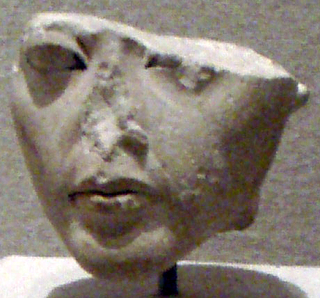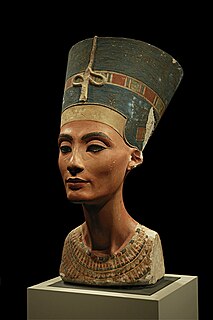The 1340s BC is a decade which lasted from 1349 BC to 1340 BC.
Contents
| Millennium: | 2nd millennium BC |
| Centuries: | |
| Decades: | |
| Years: |
|
| Categories: |
The 1340s BC is a decade which lasted from 1349 BC to 1340 BC.
| Millennium: | 2nd millennium BC |
| Centuries: | |
| Decades: | |
| Years: |
|
| Categories: |

Aten also Aton, Atonu, or Itn was the focus of Atenism, the religious system established in ancient Egypt by the Eighteenth Dynasty pharaoh Akhenaten. The Aten was the disc of the sun and originally an aspect of Ra, the sun god in traditional ancient Egyptian religion. Akhenaten, however, made it the sole focus of official worship during his reign. In his poem "Great Hymn to the Aten", Akhenaten praises Aten as the creator, giver of life, and nurturing spirit of the world. Aten does not have a creation myth or family but is mentioned in the Book of the Dead. The worship of Aten was eradicated by Horemheb.
The 1330s BC is a decade which lasted from 1339 BC to 1330 BC.
The 1390s BC is a decade which lasted from 1399 BC to 1390 BC.

Akhenaten, also spelled Echnaton, Akhenaton,, was an ancient Egyptian pharaoh reigning c. 1353–1336 or 1351–1334 BC, the tenth ruler of the Eighteenth Dynasty. Before the fifth year of his reign, he was known as Amenhotep IV.

Neferneferuaten Nefertiti was a queen of the 18th Dynasty of Ancient Egypt, the Great Royal Wife of Pharaoh Akhenaten. Nefertiti and her husband were known for a religious revolution, in which they worshipped one god only, Aten, or the sun disc. With her husband, she reigned at what was arguably the wealthiest period of Ancient Egyptian history. Some scholars believe that Nefertiti ruled briefly as Neferneferuaten after her husband's death and before the ascension of Tutankhamun, although this identification is a matter of ongoing debate. If Nefertiti did rule as Pharaoh, her reign was marked by the fall of Amarna and relocation of the capital back to the traditional city of Thebes.

Tiye was the daughter of Yuya and Tjuyu. She became the Great Royal Wife of the Egyptian pharaoh Amenhotep III. She was the mother of Akhenaten and grandmother of Tutankhamun. In 2010, DNA analysis confirmed her as the mummy known as "The Elder Lady" found in the tomb of Amenhotep II (KV35) in 1898.

Amenhotep III, also known as Amenhotep the Magnificent or Amenhotep the Great, was the ninth pharaoh of the Eighteenth Dynasty. According to different authors, he ruled Egypt from June 1386 to 1349 BC, or from June 1388 BC to December 1351 BC/1350 BC, after his father Thutmose IV died. Amenhotep was Thutmose's son by a minor wife, Mutemwiya.

Kiya was one of the wives of the Egyptian Pharaoh Akhenaten. Little is known about her, and her actions and roles are poorly documented in the historical record, in contrast to those of Akhenaten's ‘Great royal wife’, Nefertiti. Her unusual name suggests that she may originally have been a Mitanni princess. Surviving evidence demonstrates that Kiya was an important figure at Akhenaten's court during the middle years of his reign, when she had a daughter with him. She disappears from history a few years before her royal husband's death. In previous years, she was thought to be mother of Tutankhamun, but recent DNA evidence suggests this is unlikely.
Thutmose, also known as "The King's Favourite and Master of Works, the Sculptor Thutmose", was an Ancient Egyptian sculptor. He flourished around 1350 BC, and is thought to have been the official court sculptor of the Egyptian pharaoh Akhenaten in the latter part of his reign. A German archaeological expedition digging in Akhenaten's deserted city of Akhetaten, known today as Amarna, found a ruined house and studio complex in early December 1912; the building was identified as that of Thutmose based on an ivory horse blinker found in a rubbish pit in the courtyard inscribed with his name and job title. Since it gave his occupation as "sculptor" and the building was clearly a sculpture workshop, the determination seemed logical and has proven to be accurate.

Tadukhipa, in the Hurrian language Tadu-Hepa, was the daughter of Tushratta and his queen Juni, and niece of Artashumara. Tadukhipa's aunt Gilukhipa had married Pharaoh Amenhotep III in his 10th regnal year. Tadukhipa was to marry Amenhotep III more than two decades later.

The Amarna letters are an archive, written on clay tablets, primarily consisting of diplomatic correspondence between the Egyptian administration and its representatives in Canaan and Amurru, or neighboring kingdom leaders, during the New Kingdom, between c. 1360–1332 BC. The letters were found in Upper Egypt at el-Amarna, the modern name for the ancient Egyptian capital of Akhetaten, founded by pharaoh Akhenaten (1350s–1330s BC) during the Eighteenth Dynasty of Egypt. The Amarna letters are unusual in Egyptological research, because they are mostly written in a script known as Akkadian cuneiform, the writing system of ancient Mesopotamia, rather than that of ancient Egypt, and the language used has sometimes been characterised as a mixed language, Canaanite-Akkadian. The written correspondence spans a period of at most thirty years.

Ankhesenamun was a queen who lived during the 18th Dynasty of Egypt as the pharaoh Akhenaten's daughter and subsequently became the Great Royal Wife of pharaoh Tutankhamun. Born Ankhesenpaaten, she was the third of six known daughters of the Egyptian Pharaoh Akhenaten and his Great Royal Wife Nefertiti. She became the Great Royal Wife of her half-brother Tutankhamun. The change in her name reflects the changes in ancient Egyptian religion during her lifetime after her father's death. Her youth is well documented in the ancient reliefs and paintings of the reign of her parents. Ankhesenamun and her husband Tutankhamun shared the same father, but different mothers. The mummy of Tutankhamun's mother has been identified through DNA analysis as a full sister to his father, Akhenaten, and as a daughter of his grandfather, Amenhotep III. So far his mother's name is uncertain, but her mummy is known informally to scientists as the Younger Lady.

The Egyptian Museum of Berlin is home to one of the world's most important collections of ancient Egyptian artefacts, including the iconic Nefertiti Bust. Since 1855, the collection is a part of the Neues Museum on Berlin's Museum Island, which reopened after renovations in 2009.

Atenism, the Aten religion, the Amarna religion, or the "Amarna heresy" was a religion and the religious changes associated with the ancient Egyptian Eighteenth Dynasty pharaoh Akhenaten. The religion centered on the cult of the god Aten, depicted as the disc of the Sun and originally an aspect of the traditional solar deity Ra. In the 14th century BC, Atenism was Egypt's state religion for about 20 years, before subsequent rulers returned to the traditional polytheistic religion and the pharaohs associated with Atenism were erased from Egyptian records.
The Amarna Period was an era of Egyptian history during the later half of the Eighteenth Dynasty when the royal residence of the pharaoh and his queen was shifted to Akhetaten in what is now Amarna. It was marked by the reign of Amenhotep IV, who changed his name to Akhenaten in order to reflect the dramatic change of Egypt's polytheistic religion into one where the sun disc Aten was worshipped over all other gods. The Egyptian pantheon was restored under Akhenaten's successor, Tutankhamun.
Penthu was an Egyptian noble who bore the titles of sealbearer of the King of Lower Egypt, the sole companion, the attendant of the Lord of the Two Lands, the favorite of the good god, king's scribe, the king's subordinate, First servant of the Aten in the mansion of the Aten in Akhetaten, Chief of physicians, and chamberlain. These titles alone show how powerful he would have been in Eighteenth Dynasty Egypt.

The Eighteenth Dynasty of Egypt is classified as the first dynasty of the New Kingdom of Egypt, the era in which ancient Egypt achieved the peak of its power. The Eighteenth Dynasty spanned the period from 1550/1549 to 1292 BC. This dynasty is also known as the Thutmosid Dynasty for the four pharaohs named Thutmose.
The Amarna Era includes the reigns of Akhenaten, Smenkhkare, Tutankhamun and Ay. The period is named after the capital city established by Akhenaten, son of Amenhotep III. Akhenaten started his reign as Amenhotep IV, but changed his name when he discarded all other religions and declared the Aten or sun disc as the only god. He closed all the temples of the other Gods and removed their names from the monuments. Smenkhkare, then Tutankhamun, succeeded Akhenaten. Discarding Akhenten's religious beliefs, Tutankhamun returned to the traditional gods. He died young and was succeeded by Ay. Many kings did their best to remove all traces of the period from the records. The Amarna art is very distinctive: the royal family was portrayed with extended heads, long necks and narrow chests. They had skinny limbs, but heavy hips and thighs, with a marked stomach.